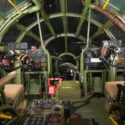
Like most things in aviation — and society — evolution occurs. The cockpit of the warbird has evolved more than many.
From the very early days of the open cockpit aircraft with fleece-lined leather clad pilots to high-tech, all weather fighting machines, Fighting Cockpits by Donald Nijboer dives deep into more than 50 warbird cockpits.
Following are handful of the more than 200 images from the book.
de Havilland DH.4
“By the end of World War I, British cockpits were better furnished than their German counterparts. This de Havilland DH.4 two-seat daylight bomber is a fine example. As most pilots were right-handed, the throttles and elevator trim were located on the left with the stick on the right.”
Royal Aircraft Factory S.E.5a Scout
The Scout “was flown by 217 aces with no fewer than 20 of them scoring more than twenty victories.”
Bristol F.2B
“The F.2B is a big, complex biplane. With all the Shuttleworth Collection airplanes, there are no dual checks. You’re briefed by whoever is the type specialist and then off you go,” noted Shuttleworth Collection pilot Rob Milinship. “The view from the cockpit is good. The Bristol fighter cockpit sides are set quite low giving you excellent side-to-side view.”
AEG G.IV
“Well liked by its crews, the AEG G.IV was considered rugged and easy to fly. Crew accommodation was sufficient for a crew of four, but most sorties were flown with a pilot, commander, and gunner.”
Supermarine Spitfire Mk Vc
“The undercarriage selector lever is on the right side of the cockpit. Meaning just after takeoff you have to let go of the throttle, change hands on the stick, reach down with your right hand, and operate the gear,” says Vintage Wings of Canada pilot Rob Erdos. “Most would consider that a dumb design, but there’s a good reason for it. The hydraulic pump on the Merlin is on the aft upper right side of the engine. Run the hydraulic lines straight back and they end up on the right side of the cockpit.”
Handley Page Halifax Mk VII
“This is a single-pilot airplane just as the other RAF four-engine bombers are. A flight engineer’s panel is installed behind the pilot. Duties seem to be very cleverly divided between the two in that the pilot is solely concerned with flying the airplane, which is as it should be for night missions and details such as starting, stopping, fuel system operation, engine functioning; and coolant and cowl flap operation and emergency system operation have been left to the flight engineer.”
Heinkel He 219 A-2/R4
“It was a remarkable aircraft with a number of innovations. Not only was it one of the first aircraft to have an ergonomic cockpit it was also the first production aircraft with ejection seats for both crew,” stated Captain Eric Brown, RN (Ret.) “They worked beautifully.”
Boeing B-29A
“The view through the big round bubble nose is terrible,” says David Oliver, Director of Operations, B-29/B-24 Squadron, Commemorative Air Force. “The windows are not as big as you think and there’s so much metal framing it always seems as if there’s a piece blocking your view. A lot of our new pilots do what we can “shadow boxing”- constantly moving their heads back and forth trying to find a better line of sight.”
McDonnell Douglas F-15A
“To help acquire a target visually we would use the forward windscreen canopy bow as a visual aide,” noted Lieutenant Colonel Cory Bower, USAF (Ret.) “It’s called using the “canopy codes.” When the radar gave you a target 20 degrees to the left, you knew exactly here to look in relation to the canopy bow.”
Lockheed Martin F-22 Raptor
“When you first get into the cockpit there’s no power and there’s not a single old-fashioned round steam gauge anywhere,” said Lieutenant Colonel Clayton Percle, USAF, 525th Fighter Squadron Commander. “It’s all multifunction displays and very sparse. Not a lot of switches compared to the F-15. The stick is in the wrong place as well. As a good ole-fashioned fighter pilot, I was very comfortable with it right there in the middle.”
Fighting Cockpits
The range of warbirds covered by Fighting Cockpits is truly amazing. Copious “Pilot Impressions” give the reader a first person glimpse of strapping on many of the most famous warbirds. Dan Patterson’s imagery puts the reader in the cockpit. Not easy with such cramped space in many of the smaller aircraft.
Fight Cockpits is available from your favorite retailer (Amazon, Barnes & Noble, others).
Source: http://generalaviationnews.comThe evolution of the warbird cockpit










